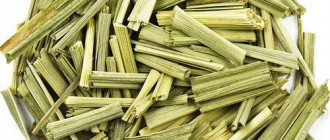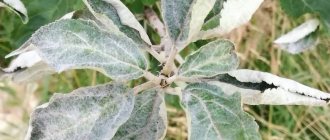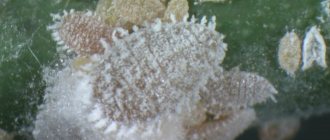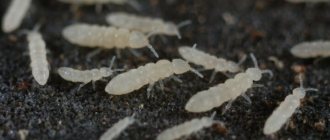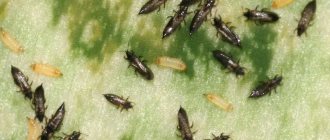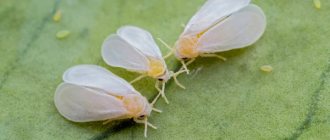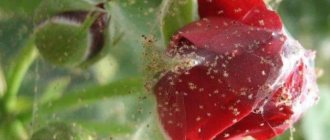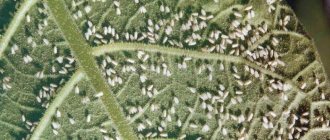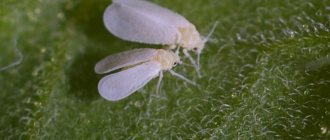- Diagnosis of thrips damage
- Prevention
- Thrips control
Thrips are tiny insects, black in color, reaching 1 mm in length. Thrips on indoor plants are quite common, they spread quite quickly, can easily jump from one plant to another, cause harm to many plants, but most often they affect fuchsia, begonia, and codiaum. More than 5,700 species of this insect are known; more than 700 species live on the European continent. The body of thrips is elongated; they feed on plant juices. Thrips cause great damage to cultivated plants. Thrips try to lead a hidden lifestyle; it can be difficult to detect the first outbreaks of this insect. Thrips move from one leaf to another, leaving behind a white or silvery coating. Thrips cause great harm not to leaves, but to flowers. Flower thrips severely affects the flowers of the plant; they become covered with a white coating, spots, become severely deformed, and eventually simply fall off. Thrips can greatly weaken a plant, its growth rate will begin to decrease, and it is possible that shoots will stop appearing. Thrips also carry various diseases that are dangerous to the plant, such as anthracnose.
Pests of indoor plants
Mostly, flower growers are bothered by the following types of parasites.
White bugs in the ground
White bugs that live in the soil are called white bugs. This insect can jump. The parasite has an elongated body on which sparse hairs grow, and there are antennae on the head.
There are hundreds of pests of indoor plants, and each has its own remedy.
They usually appear in soil layers rich in humus. White podura feeds on plant debris, but the living root system also suffers from it. Damaged roots cannot cope with their function, as a result the flower stops developing and may die.
If small white bugs appear in indoor flowers in the ground, then you need to:
- reduce watering, as bugs do not reproduce well in dry soil;
- be sure to provide good drainage in the pot to prevent mold and souring of the soil;
- dilute the soil with sand.
For your information! You can take a potato tuber, cut it in half and place it on the surface of the soil. After 2 hours, the vegetable will be covered with parasites and can be thrown away.
Among the chemical preparations you can use pochin, aktar, bazudine.
Black bugs on indoor plants
Black bugs that appear on indoor flowers are sciarids, or fungus gnats (black fly). This is a two-winged insect measuring up to 7 mm. She has an elongated dark body and black wings, but some females do not have wings. The adult black fly has long legs and whiskers.
Particularly dangerous for indoor plants are the larvae of the parasite, which feed on decaying tissues in the soil and damage the roots of flowers.
To get rid of pests, it is recommended to treat the soil with a slightly pink solution of potassium permanganate. You can chop dill and sprinkle it on the top layer of soil, it will repel parasites.
Chemicals that are effective against fungus gnats include Pochin, Aktara, and Grom-2.
Aphids are an enemy for plants with soft tissues
Aphids feed on plant sap, piercing leaves and green shoots with their sharp proboscis.
Aphids can destroy a flower in a matter of days.
You can see light dots at the puncture site. The parasite itself is easy to see with the naked eye. The insect is green in color, its size reaches 2 mm. Aphids can be with or without wings. During the life of the insect, honeydew is released, which glues young leaves and buds together. Next, ants appear and feed on the honeydew.
Important! When fighting aphids, you need to take into account that the larvae live not only on the surface of the flower, but also in the soil.
The damaged plant should be washed in the shower, since aphids do not adhere well to the flower and are easily washed off with water.
The pest does not like crops that smell strongly, for example, geranium, so it is recommended to place it next to the infected specimen.
An infusion of citrus peels helps against the parasite. To prepare it, you need to add 1 liter of water to 4 tbsp. spoons of zest. Or you can use ready-made chemicals: Aktar, Confidor.
Onion root mite
Onion root mite damages the underground root system of bulbous plants. When infected, the root crops turn into dust and fall off, the plant itself stops blooming and withers.
To detect the pest, you will have to remove the flower from the pot. Therefore, it is possible to understand that a plant is infected only when it begins to wither.
Onion root mites can appear in pots that do not have drainage, if you water the flower abundantly and place it near a warm radiator. In addition, the pest often settles in old soil, which has become compacted over time and no longer allows air to pass through.
If a mite has settled on a plant, it should be kept away from healthy crops. A sick flower needs to be examined and, if the root system is severely damaged, it is better to throw it away. When the roots can be saved, they are washed with running water and placed in a solution of an insecticide, for example, Apollo, Neoron, for 12 hours. The pot also needs to be rinsed with water and disinfected.
Traditional methods, for example, nettle infusion, also help in the fight against root mites. To prepare it, 700 g of fresh herbs should be poured into 5 liters of boiling water. Pour the infusion into a sealed container, place it in a warm place for 5 days and stir periodically all this time. Then it should be filtered, diluted in a ratio of 1:10 and the plant should be watered with the solution.
Note! Instead of nettle, you can use horsetail or wormwood.
Spider mite
Spider mites are small parasites that measure up to 1 mm. Usually it is not visible to the naked eye, but you can suspect that the pest has settled on the plant by the web that appears on the leaves, shoots and other parts. You can see light puncture spots on the leaves, which also indicate insect infestation. Although the pest is small in size, it is very dangerous, as it quickly spreads on the bush and causes its death.
After infection, the leaves and shoots quickly become covered with a sticky web, and the mite begins to suck out all the nutrients, causing the leaves to turn yellow and wither. The plant becomes unstable to fungal infection and dies after a while. If a spider mite gets on a flower once, it is almost impossible to get rid of it, since part of its population remains in the ground. As soon as the plant weakens, the pest will begin to multiply on it.
For your information! The insect can settle on any home flower, but ficus, roses and citrus fruits are especially sensitive to it.
To cope with it and save the plant, you need to start fighting spider mites at the first signs of infection. To get rid of the insect, you can use special chemicals, for example, Fitoverm, Apollo.
You can also use traditional methods:
- grate 20 g of laundry soap and dilute it in 1 liter of warm water. Leave the resulting liquid for a couple of hours, after this time the solution is mixed and it can be used. The soil in the pot must be covered with cellophane so that the soap solution does not get on the roots, otherwise the flower will die. You need to wet a sponge with the liquid and apply it to the entire above-ground part of the plant. The soap foam must be left on the flower for 4 hours and then washed off. The treated plant must be covered with a plastic bottle for 24 hours. This is necessary to maintain high humidity, which spider mites do not like;
- chop 20 g of garlic and pour 1 liter of water into it. The resulting solution can be sprayed on the infected plant. If an indoor flower does not tolerate spraying, then chopped garlic can be placed next to the infected plant and covered with a bag, which must be removed after a couple of hours.
Greenhouse whitefly
The orange or greenhouse whitefly is a small butterfly. The length of females reaches 1.3 mm, and males - 2.5 mm. Not only adult whiteflies are dangerous, but also their larvae.
How to deal with them at home?
Pest control methods depend on the type of disease. Radical methods involve treating greenery with chemicals. Biological agents have a gentler effect on flowers, but quickly dissolve in the soil. At the initial stages of the disease, traditional methods are also effective.
Mechanical methods of control
Mechanical methods involve physical extermination of pests. In addition to destruction, flower growers block insects' access to plants.
In practice, this method consists of simple steps:
- collecting insects by hand (if their size allows). Scale insects, scale insects and caterpillars “come unstuck” from the leaves. It is important to clean the plants carefully so as not to damage them;
- wiping with a cotton pad. Soaked cotton wool helps get rid of aphid accumulation;
- contrast shower and water spraying. If insects are concentrated on the green part of the plant, then targeted watering will get rid of them.
Important! Mechanical methods help remove only part of the pests from the plant. No gardener can clean a flower completely by hand. This method is the initial stage in a long struggle.
How to spray with chemicals?
There are no universal instructions for treating plants with chemicals. Each drug has its own characteristics and corresponding instructions.
There are two methods of moisture distribution:
- water mist. Fine spray nozzles are used to create fog. After spraying, the water does not flow into the soil and falls evenly on the leaves. The method is used for those chemicals that should not get into the ground;
- splashing. Used for spot processing. The method involves a large consumption of water, which saturates the soil. It is effective in situations where small areas of the plant are treated.
Important! When working with chemicals, consider their expiration dates and do not exceed the dosage. Too much medication can cause more damage than the disease.
Biological
Biological methods involve the use of fungicides based on beneficial bacteria. These drugs lead to the death of pathogenic microorganisms and do not damage the plant.
The advantage of biological fungicides is their low level of toxicity. But compared to chemicals, they show less effectiveness.
Fungicides are used in three directions:
- dressing seeds before planting;
- spraying the above-ground part of the plant;
- soil impregnation.
Based on their intended purpose, biological drugs are divided into preventive and therapeutic.
Preventive ones help the plant maintain immunity and act as a protective layer. Therapeutic treatments are used when the disease has been identified.
The composition of fungicides classifies drugs into one of the groups:
- organic - decompose in the soil with the help of microorganisms;
- inorganic - contain metals that are stored in the soil.
At home, gardeners treat plants with the following fungicides:
- gamair P;
- Alirin-B;
- phytosporin;
- agate;
- baktofit;
- trichodermin.
Important! Treatment of plants with biological preparations is carried out early in the morning.
Folk ways to treat the land against diseases
Traditional methods of combating diseases of indoor plants suggest trying the following components:
- citrus. Citrus peels repel fools. Oranges, tangerines, grapefruits and limes are used. The peel is pre-crushed and then distributed over the surface of the soil;
- garlic. To prepare the infusion, take one crushed head of garlic and pour in a liter of boiling water. The liquid is infused for one week and then diluted with water. For a liter of clean water, 5 milliliters of infusion is enough. The solution is poured into a spray bottle, with which you need to spray the plant evenly;
- potassium permanganate. A solution of potassium permanganate is effective and dangerous at the same time. Excess potassium permanganate will cause burns to the roots of the flower. To avoid this, it is necessary to dilute potassium permanganate in stages. The liquid is used to spray leaves and soak the soil. It is effective against aphids, mites and whiteflies.
Important! Traditional methods help in the initial stages of damage. Advanced stages require the use of drugs.
Diseases of indoor flowers
Diseases of indoor plants are associated with improper care.
White coating on the ground in pots
A white coating on the soil in potted indoor plants can be caused by watering with hard water. To soften the water, you can boil or freeze it and then water the flowers.
When the white coating is soft to the touch, it is mold. To get rid of it, you need to reduce watering and remove the layer of soil covered with mold. The soil must be treated with antifungal agents. To treat fungus, you can use drugs such as Topsin M, Sarfun 500 SC.
The appearance of a white coating resembling cotton wool on plants is associated with mealybugs. Parasites can reach a length of 1 cm. The insect settles on the inside of the leaf and feeds on the sap of the plant. When indoor flowers have a white coating like cotton wool, what to treat, you need to ask first, otherwise the plant may die in a matter of days. To save an infected crop, you can use the means admiral, commander, and tanrek.
Why does soil in pots become moldy?
There are several reasons why the soil in a pot becomes moldy. Mold can be associated with excessive watering and frequent spraying. To prevent it from appearing, you need to water the plant when the top layer of soil dries 2 cm. You also need to make drainage in the pot.
Note! The soil may begin to turn white due to a large amount of fertilizer.
Sooty fungus on indoor plants
Sooty fungus, or black fungus, is an infectious disease. A plaque forms on the plant, which clogs the stomata on the leaves, as a result of which photosynthesis is disrupted, the flower lags behind in development and weakens.
Sooty fungus disrupts photosynthesis
To prevent the development of infection, you need to promptly spray the plants against parasites that form sweet secretions. These are insects such as aphids, thrips, and scale insects.
The infected plant should be wiped with soapy water and then rinsed with warm water. After this, to cure the flower, you need to treat it with phytosporin.
You need to get rid of pests of indoor flowers as quickly as possible, otherwise the affected plant may die before your eyes. In addition, insects, having destroyed one flower, quickly switch to another. Therefore, in order to preserve your home collection, it is worth carefully inspecting each specimen and taking timely measures to combat unexpected guests.
How to identify parasites?
A florist can diagnose a flower disease only by external signs. The leaves give basic information about the condition of the plant. They may change color, dry out or fall off. Another alarming symptom will be the appearance of a rotten smell.
We will talk about what signs you should pay attention to when examining home flora in this section.
The appearance of a white coating
A white coating indicates that the plant has been attacked by insects or microorganisms. If a gardener discovers whitish marks on the leaves, it is necessary to quickly take measures to save the flower.
The culprits for the appearance of plaque may be:
- powdery mildew - rapidly spreads throughout the flower and covers it with mycelium. Dew selects those plants that are over-watered. Fluctuations in room temperature can also be a pretext for the appearance of spores. The disease is contagious and dangerous to nearby plants. During treatment, the infected flower must be isolated;
- Mealybugs - insects settle on the underside of the leaf and suck moisture from the plant. Due to the fact that the leaves get stuck in the honeydew, the plant begins to wither and soon dies;
- mold - the appearance of mold spots confirms that the flower is damaged by fungal mycelium. Mold is not considered a disease, but can deplete flora. It appears from excessive watering of the plant. In order to cope with this fluffy coating, it is necessary to reconsider the spraying scheme;
- gray rot - at the initial stages, rot is localized on the stems and leaf petioles. Over time, it takes over the entire plant. It will not be possible to cure a flower from gray rot, since all medicines are powerless. The only way to combat the disease is to destroy infected specimens.
Reference. The appearance of all ailments that cause white plaque can be prevented with proper care. If the grower begins to monitor temperature conditions and watering, his plants will remain healthy.
What do yellow spots signal?
Yellow spots are a general symptom that does not relate to a specific disease. Yellowing of leaves is caused by both fungal diseases and errors in care.
Among the prerequisites for the formation of yellow spots are:
- temperature violation. If the temperature is incorrect, the leaves turn yellow, red or white. The color change is accompanied by the formation of a crust due to sunburn. To save the flower, you need to move it to the shadow side. It is advisable to remove damaged leaves;
- inconsistent watering. Yellow-brown spots are a sign of a thirsty plant. Lack of moisture causes the edges of the leaves to dry out. The spots then spread throughout the flower. If the affected areas are soft, then there is excess moisture;
- incorrect feeding scheme. Plants that are overfed with inappropriate fertilizers suffer from chlorosis. The disease prevents the leaves from producing chlorophyll, which affects their appearance. Chlorosis is easy to recognize - green areas remain only in places where veins are present;
- unsuitable conditions. Tender plants do not respond well to water if it gets on their leaves. This one event can cause yellowing. Another common cause is old potting soil.
Deformation of flower leaves
Deformation or “curl” of leaves is characterized by the growth of individual sections of the leaf and the formation of swellings. The swellings become green, yellow, pink or white.
The presence of such changes may indicate:
- vital activity of ticks;
- viral activity;
- development of fungal infection;
- exposure to chemicals;
- burn.
Deformation of the leaves is not dangerous to the life of the flower. An unfavorable prognosis awaits the plant if it suffers from a virus or a chemical burn.
Chemical burns occur due to improper application of fertilizers. They are characteristic of garden plants, but are also found in indoor plants. Dealing with a burn is not easy because it affects both the plant and the soil. It is impossible to transplant weakened flora into new soil without consequences.
Reference. If the deformation is at the initial stage, then it needs to be combated by improving the soil. The grower must loosen the soil and add new soil. It is advisable to use drugs that stimulate plant growth.
Pests of indoor plants with photos and names
All plants, no matter where they are grown, are subject to invasion by various pests. In addition, indoor plants that housewives love to grow are susceptible to various diseases and the harmful effects of various insects. Various reasons contribute to this. Often housewives themselves are to blame for this, since they do not create the proper conditions for growth and development for plants. Some of them simply forget to water the plants, and some of them water them excessively. It should be noted that there are quite dangerous pests that can reduce a person’s work to zero.
The main reasons for the appearance of parasitic bugs on orchids
Have you ever analyzed the reasons for the appearance of a mosquito or midge on your beautiful body?
- Forgot to apply a special cream or ointment?
- Is the ointment (cream) bad? But I asked for a good seller!
- Have you forgotten the natural and elementary conditions? This is their way of life. As soon as there are suitable conditions, they appear.
That's it with pests. They don't appear out of nowhere . You have purchased a wonderful plant. Orchid. Some people have never heard such a name in our area. And the pests are so familiar. And why did they start?
Important! Do you know the type of orchid? Have you created the right conditions for her? And what could be the reason for the appearance of unwanted guests?
analyze your . Before looking for the culprits.
Overflow
How should I water? The general rules are:
- Each species is watered in a way suitable for it;
- Excessive watering does not allow the substrate to dry out;
- Various bugs can grow in a substrate oversaturated with moisture;
- Overwatering leads to stagnation of moisture and renders the substrate unusable. And it creates conditions for those who like to profit from orchids.
Poor quality substrate
Insects in the soil are not uncommon. The appearance and presence of orchids in the house requires the creation of optimal conditions for them :
- A high-quality substrate will help plants grow actively. From it the plants receive the necessary nutrients;
- It's not just taking soil from the forest or from the garden. A special substrate is selected for epiphytic orchids . With conifer bark, charcoal, peat and moss. With good moisture holding capacity and air permeability;
- The risk of bug pests appearing in the soil for orchids will be significantly less. If you purchase a substrate in specialized stores for a specific species, you will be offered the appropriate option;
- When independently preparing substrate components (especially bark), be sure to heat treatment procedure;
- And treatment with insect and bug repellents. If you process the container, this will also not be superfluous.
Buying an infected plant from a store
Parasites often come to your pets with new acquisitions . They are treated with various drugs for sale. But where and how long can they be located? And what plants are sold nearby? And pests are usually not that specific. And many are common to indoor plants.
So many gardeners advise, when purchasing, to carefully examine the plant for the presence (absence) of external signs of pests:
- Various points, cobwebs, galls indicate their presence;
- And it is undesirable to bring home a breeding ground for pests. Maybe quarantine won't help.
Before buying in a store, check the orchid for pests.
Experienced flower growers can deliberately buy a plant with bugs . If they know what kind of insects these are and what to do with them. But the price is reduced significantly.
Infection from other indoor flowers
The situation is very similar:
- Orchids appeared not so long ago. But many flower lovers have roses, violets, and “Ladies’ Happiness” in their home collections;
- And pests appear. Aphids, spider mites and thrips are not uncommon. Their mobility is simply amazing. They move to healthy plants very quickly.
Advice! Quarantine for purchased plants must be observed. This is also a good reason to take a good look at your home flowers. Are there any dangerous bugs on them?
Whitefly
This is an insect with a body length of no more than 2 mm. A characteristic feature is white wings and a yellowish body. They can be found:
- On the back side of the leaves, where they are located in colonies.
- According to characteristic sweetish traces, on which after some time a sooty fungus appears.
Whitefly larvae have a sucking type of mouthparts, so they suck out the juices from the plant. As a result, the plant loses its vitality and gradually loses its attractiveness. If no measures are taken, the plant will soon die.
Interesting fact! When appearing in greenhouses, the whitefly prefers plants such as hibiscus, pelargonium or begonia. After the appearance of just one individual, after a short period of time a whole colony of these insatiable pests appears in the greenhouse. In this regard, the fight should begin immediately.
These are also harmful insects that suck juices from plants due to the presence of piercing-sucking mouthparts. Insects have an ovoid body shape, no more than 2 mm in length. Aphids have rather long legs, but they move rather slowly. The color of insects depends on the species, as well as on living conditions, so it can be varied.
There are both winged and wingless types of insects. Naturally, insects with wings can easily enter a person’s home, even through an open window.
Fungicides
In specialized gardening stores you can purchase preparations that contain live microorganisms that destroy pathogenic flora and diseases caused by it.
Fungicides have attracted the attention of flower growers for their simplicity and speed. The main thing is to strictly follow the recommendations described in the instructions so that the drugs show their full properties. Sprinkle the prepared solution onto the soil and wait for the beneficial bacteria to multiply. This takes several weeks. Fungicides are not a hindrance if an indoor flower is already growing in the soil.
The preparations are used not only to destroy mold spores or harmful fungi, but also to restore soil microflora after calcination and steaming.
All disinfection methods will not help if disinfected soil is placed in used pots. Harmful microorganisms are located, multiply and thrive on the walls and soil residues. Therefore, containers for planting should be treated with disinfectants - potassium permanganate, soda, fungicides.
If you do not neglect the disinfection of soil and planting materials, especially for indoor plants, a lot of problems will not affect them in the future, and caring for flowers will be easy and pleasant.
Hairy aphid
This type of aphid is also called mealybugs. They are one of the most dangerous insects for plants. As a rule, they can be found on the underside of leaves. Their presence is indicated by a cobweb-like white coating, as well as the presence of a sticky liquid.
These insects are distinguished by a high degree of fertility. Female mealybugs lay eggs in miniature formations that resemble balls of cotton wool. After a certain time, fairly mobile larvae emerge from these lumps, which are then distributed throughout the plant. Fighting them requires an instant reaction. The sooner you start fighting this pest, the greater the chance of saving the plant.
How to get rid of them?
Whatever type of beetles appears in a house or apartment, the first thing you need to do is find nests with larvae. It is pointless to destroy only adult individuals on the windowsill. Very soon new offspring will emerge from the nest, and the number of pests will grow rapidly. The female lays several dozen eggs at a time.
If adult beetles are found on the windowsill, there are larvae and eggs somewhere in the house, and in large quantities.
A step-by-step guide will help you quickly and permanently solve the problem of small bugs in your apartment:
- It is necessary to inspect food supplies, cracks and cracks in window frames, the space behind baseboards, inside furniture, under the carpet, leather and fur clothing, shoes in the shoe rack, and all dark secret corners. It will be easier to detect bug nests if you first determine their type and find out what they eat.
- Bug nests can be numerous and scattered throughout the house. It's important to find them all. They are usually full of eggs and larvae, and are covered in dust from food and objects eaten.
- Remove the larvae. You need to thoroughly wash the surfaces, steam, wash, freeze.
- Treatment with chemicals (insecticides) is carried out whenever possible and is not of primary importance, especially if food or a children's room is contaminated.
- Throw away or quarantine all potentially contaminated food and items. Quarantine means storage in thick polyethylene for 3 months. If during this time no larvae or bugs appear inside, it means that the product (item) was not contaminated.
- Carry out prevention for 6-12 months after detecting bugs on the windowsill.
Root mealybug
This type of pest poses the main threat to the root system of plants. The parasite can be detected either in the ground or on the lower part of the plant stems, by a whitish coating. Females reach a length of up to 2.5 mm, while they are larger than males and much more mobile. Pests are distinguished by their almost cylindrical body shape, covered with a waxy coating. Females lay eggs in special chambers formed by special secretions.
Males are more like whiteflies. As adults, they quickly die because they stop feeding. Therefore, females make up the main population of these pest colonies.
It is important to know! The presence of such insects on indoor plants leads to the fact that the plants lose their attractive appearance. In addition, damaged plants begin to suffer from fungal diseases.
Shchitovka
Scale insects also appear on house plants, and each type of scale insect can infect a specific type of plant. The palm scale insect parasitizes the shoots of palm trees. There are also cactus, pink, ivy, Californian, laurel, and oleander scale insects. Often scale insects appear on lemons or orchids. A characteristic feature of these pests is the shell that protects their body. In this regard, it is quite difficult to fight scale insects.
The false scale insect, which does not have a waxy shell, poses a huge danger to plants. The females of these pests grow up to 5 mm in length, and they have neither legs nor wings, unlike males. Females are distinguished by the fact that their body is covered with a convex shield, which can have different shapes, both round and oval.
These parasites prefer to be found on any part of the plant, both on the stems and on the back of the leaves. There is also a hemispherical scale insect, which is slightly larger in size and volume. Plants such as ferns, asparagus and myrtle are affected by these pests. Below is the appearance of some pests of indoor plants.
Causes of the threat of plant damage and preventive measures
Knowing the ways in which pests of indoor plants enter the home makes it possible to develop a system of preventive measures against this serious threat. The following dominant reasons are identified:
- improper care;
- purchasing an infected plant in a store or receiving a gift;
- transfer on items of clothing, with bouquets of meadow flowers.
The following actions can be classified as preventive measures:
- shopping at reputable specialized salons;
- obtaining preliminary complete information about the resistance of a particular variety to damage by pests or diseases;
- when propagating yourself, careful sorting of seedlings and pre-planting disinfection;
- taking into account the characteristics of each individual species to comply with the rules of care;
- regular monitoring of the external condition of the home green corner;
- immediate isolation of a weakened plant that is beginning to dry out, followed by its treatment.
White fool
White podurs are hopping insects that can be found in potted houseplants. They differ:
- An elongated body on which sparse hairs grow.
- Having 3 pairs of legs.
- Having a long mustache.
- Prefers moist conditions.
The diet of these pests includes the remains of plant components, as well as a living root system. If you do not pay attention to these parasites in time and do not destroy them, they can lead to the death of indoor plants.
Spider mite
Many indoor plant lovers are familiar with this common and quite dangerous pest. This is a tiny insect that can only be detected with a magnifying glass. Colonies of these insects are found on the underside of leaves. Spider mites prefer warm and dry air. Under such conditions, the insect reproduces at a tremendous rate.
You can determine that a plant is infected with spider mites:
- By light spots that are visible in places where pests live.
- By the presence of the finest cobwebs that cover plants.
Chinese roses, geraniums and palm trees suffer quite a lot from the invasion of spider mites, which suck the juices out of them.
Useful tips
Experienced gardeners advise how to prevent or prevent pests from infecting indoor plants:
- A new plant purchased may be infested but appear healthy, and symptoms may appear later when the pests have multiplied. It needs to be placed separately from the others and observed for some time.
- Inspect the plants. If harmful insects are found on any of them, it is isolated from others and treatment is started immediately.
- Before planting, the soil can be calcined in the oven or frozen to destroy the larvae or eggs of harmful insects.
- If there are not many pests on the plant, you can use folk remedies. If the damage is severe, it is better to immediately use chemicals.
- Follow the rules of care: watering, fertilizing.
Thrips
These are insects whose length does not exceed 1.5 mm. Pests can be identified by their black or dark brown body color, with the lower part of the body being a reddish-yellow hue. Like most pests, thrips hide on the underside of leaves. The female lays eggs in very small holes, which she gnaws in the leaves and also in flower buds.
It is important to know! The appearance of a silver pattern on indoor plants indicates that the plants are infected with thrips. These are traces of their life activity.
Fungus gnats are a flower pest
The small black adult insects that fly around the plant are harmless. The danger comes from tiny white worm-like larvae with black heads that hatch from their eggs. The larvae feed mainly on organic residues in the soil, and sometimes devour young plant roots. They can be especially dangerous when the soil moisture is high. Water the soil with insecticide.
Usually these insects enter the house along with the soil, where they develop in the form of larvae, similar to small short worms, and as a result of metamorphosis they turn into small black flies. As a rule, they do not harm plants. Their appearance is associated with excess soil moisture and the use of a substrate rich in organic matter.
Control measures
How to get rid of pests? This question haunts many indoor plant lovers. Pest control can be done in a variety of ways. For example:
- Mechanical.
- With the help of biological drugs.
- Using chemical control agents.
- Based on folk recipes.
Mechanical method
This is an environmentally friendly, simple and affordable way to combat parasites on your own. To do this, you need to take a tool, preferably disinfected, and cut off the damaged parts of the plants. It is better to treat the cut areas with activated carbon. Pests that can be seen with the naked eye can be picked out with your hands without any problems, unless there are so many plants and pests.
Black bugs on flowers - who are they and why are they dangerous?
The fungus gnat is a sciarid (flower midge, soil gnat, detritus gnat), dipterous insects up to 7 mm in length, an elongated dark body and almost black wings, with long antennae and legs. Some females lack wings.
For indoor flowers, the most dangerous are the larvae of fungus gnats, which in the soil feed on the remains of decaying tissues and eat up the roots of plants.
Scale insects are arthropods, hemipteran insects, with strong differences between males and females. Young females have a soft, waxy shield of almost white color; males are very small, almost invisible, and die after fertilization. In adult females, the scutellum becomes more rigid and dark brown in color, hardening on the leaves of plants.
The scale insect causes significant harm by sucking out the sap of the plant; sticky marks and yellowing appear at the site of the sucker. It is especially dangerous for citrus crops, where it damages the ovary.
Thrips (blue-legged) are small, up to 1.5 mm, black insects with an elongated body and wings.
They are dangerous for all plants, as they suck out the juice, after which the leaves of the flower fall off. Thanks to their wings and long, fast legs, they move among all flowers and lay many larvae.
Every person who grows indoor plants can encounter other pests:
- aphid;
- enchytraea - white annelids;
- whitefly;
- spider, flat-bodied, cyclomene or root mites;
- mealy or root bug;
- nematodes;
- idiots.
Where do black bugs come from on potted flowers?
Black bugs can appear on indoor flowers at any time of the year and multiply quickly, because a warm room contributes to this.
Where do they come from:
- brought in from an open window with air and wind;
- along with flowers purchased in stores;
- when purchasing soil for plants;
- from a personal plot, soil taken from it;
- with bouquets of flowers purchased in flower shops or brought from the fields.
- with shoes and clothes, especially if you went on picnics.
Brown bugs on the windowsill - what are they called?
When we talk about “small” bugs, we most often mean bugs the size of a match head, or even smaller. Several hundred pests fit this description. But in houses and apartments, 2 types are most often found:
- Carpet beetle.
- Grinder.
It is believed that the first one starts due to dust, a large number of old things in the house, carpets, and the second one feeds on flour and cereals. They end up on the windowsill, like many other insects, by flying into the light. In the evening, the bugs move into the ceiling lamps, where they often die.
Carpet beetle
The pest is very common in private homes, but can also live in apartments. He was nicknamed the Kozheeder for his passion for leather goods, and in particular, for museum stuffed animals. He is not interested in human skin. In general, the bug is almost omnivorous. He eagerly eats bread crumbs, nuts, fur products, carpets, books, and wood. There are known cases where skin beetles have gnawed through plastic, asbestos, the walls of buildings, eaten stocks of beans, grain, meat, dried mushrooms and spices, and damaged agricultural vehicles.
You can recognize the skin beetle by its characteristic hard oval back. In appearance it looks like a ladybug, only dark brown or black, and very small. The length of the body does not exceed 3 mm, and a tail-tassel is visible at the tip. If you look at the bug through a magnifying glass, you will notice tiny hairs on the back.
Skin beetles have rather large and mobile larvae, about 2 mm in size. They hide mainly in dry, warm and dark corners, in accumulations of dust. A new individual hatches, on average, after 2 months. But beetle eggs in favorable conditions can survive up to 5 years.
Photo of the skin beetle:
Another notable feature of the skin beetle is its manner of movement. They prefer to slowly crawl, and at any touch they instantly roll over with their belly up, as if dead. Skin beetles can also fly, and if you crash into a person, the collision is very noticeable due to the rigidity of the bug.
Kinds
There are about 700 varieties of skin beetles. In nature, these insects process dust, feathers, wool and bones of dead birds and animals. In the absence of a natural source of food, 7 species of skin beetles live in apartments and houses:
- Ham. Well recognizable due to its characteristic color. The beetle is oblong, with a black head and lower elytra. A light gray stripe with black dots runs across the back. Body length can reach 7-8 mm. The bug prefers food of animal origin (meat and bone meal); it can eat leather and fur products, and cereals. Photo of ham skin beetle:
- Brownie. A small motley bug measuring 2-3 mm damages wool, felt, and less often meat products. Its back is covered with light gray and brown spots. Photo of the house beetle:
- Museum. In appearance and color it is similar to the house leather beetle, but is much darker. It is a dangerous pest of museum exhibits. In apartments and houses it feeds mainly on dead insects, the remains of egg capsules, cocoons, etc. What does a museum leather beetle look like:
- Carpet. It is distinguished by its coal-black color, but its antennae and paws are black. The carpet beetle is an omnivore, but prefers to feast on products made of wool and down: carpets, pillows, blankets, coats. Photo of the bug and larva:
- Fur coat. Capable of quickly destroying products made from natural wool and down. It differs from the carpet beetle in its elongated body shape and the presence of 3 small white spots on the back. The color of the bug is brown-black, the back looks like velvet. Photo:
- Grain. It eats grain and often affects warehouses where it is stored. Can destroy up to 70% of stocks in a few months. The bug has a light brown color, reddish hairs, legs and antennae. This is what it looks like:
- Kozheed Smirnova. The most common species in Russia. Smirnov's Kozheed has adapted almost as well to life near humans as cockroaches. It is omnivorous, the larvae eat the felt backing of linoleum, pet hair, dust, and food. Adults do not feed, but live off the reserves accumulated during the larval stage. The bug is brown in color. Photos close up:
Grinder
The borer beetle in nature settles in decaying wood - in stumps, dying trees, etc. The length of the insect's body ranges from 5 mm to 1-1.5 cm. The larvae of the borer are white or white-yellow, large, curved, shaped like a letter "WITH". They have well-developed legs with claws and a large head with reddish pubescence.
The grinder beetle is popularly known as the “death clock.” Moving through holes in the wood, it makes a characteristic sound. People have noticed that after the “ticking” appears, the house collapses within several years. The bug is predominantly nocturnal.
Over the years, grinders have learned to coexist with humans, and their diet has become more varied. Some bugs “specialize” in cereals, others in wallpaper glue, books, garbage, furniture, etc. Grinders are active from May to October. Photo:
Kinds
There are about 1,500 subspecies of grinders, but in the house on the windowsill you can most often find:
- Bread grinder. The bug, 1.5-4 mm in size, is brown in color and eats mainly cereals, cookies, pasta, flour, dried fruits, confectionery and spices. Grinders themselves are rarely found in products. Their milky-white oval eggs and larvae, which resemble thick worms, live there. Photo:
- Furniture sharpener. It parasitizes dry wood of any species. Gnawing holes in floors, windows, walls. The color of the bug is brown, on the back there are stripes that consist of many dots. Photo:
Prevention measures
It is not possible to completely protect your indoor plants; it is very important to carry out preventive measures.
- Do not over-moisten the soil;
- Do not leave food, stubs, or plant debris in pots that may begin to rot;
- It is not advisable to experiment with watering with fatty water with sugar or other ingredients that can become a breeding ground for pests;
- Steam purchased or collected soil in the oven;
- Spill the soil once every six months with a disinfectant solution of manganese;
- Once a week, thoroughly wash the trays and window sill with laundry soap without leaving even a residue. After washing, wipe the top with a pest repellent;
- Infected plants should be quarantined, the soil should be changed, and the roots should be washed with running water and a disinfectant.

